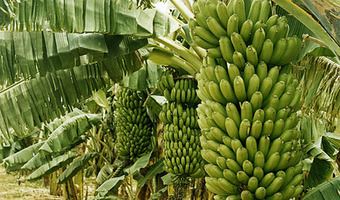 An industrious farmer from western Uganda tired of the meager earnings from his bananas has decided to delve into value addition, making banana flour which has not only tripled his earnings but protected him from market glut which is commonplace in Uganda.
An industrious farmer from western Uganda tired of the meager earnings from his bananas has decided to delve into value addition, making banana flour which has not only tripled his earnings but protected him from market glut which is commonplace in Uganda.
Having witnessed the stress banana farmers around Mbarara area, one of the leading matooke producing area in Uganda, underwent through middlemen exploitation, Winfred Kagwa decided to find a lasting solution. “As a matooke farmer, I have witnessed first on the sufferings of the farmers from the hands of the middlemen. But at the same time we are always in dilemma. We are torn between selling the bananas to the traders from Kampala at a throw away price and not selling them and leaving them to waste on the farms,” he explained.
On average traders buy a bunch of matooke from the farm in the area at about UGX2500-50000 with the same retailing at about UGX12000-25000. Kagwa has a 14 acre banana farm from which he harvests 600 bunches of matooke during peak periods. “Initially I used to sell my monthly harvests from the farm between UGX2500 and UGX5000 per bunch to the traders before setting up my small firm for value addition. The prices were disincentive as I was not able to even lead a comfortable life despite the fact that I was harvesting plenty of food.” After the expenditure on the farm he was always left with very little money that could barely support his family of seven.
Kagwa’s fortune script changed for better when he attended a farmers’ empowerment workshop organised by the National Agricultural Advisory Services (NAADS). The training was mainly centered on value addition. He was inspired through the speakers at the training and success stories he got from his fellow farmers that were already in the value addition sector. As a result, he set out to look for capital to see off his dream. “I got in touch with other successful model farmers in Bushenyi who had adopted value addition in order to learn more and get tips for starting off,” he added.
Armed with his little life time savings of about UGX3.5million, Kagwa procured the essential machineries needed for setting off in 2010. As is always in most cases, the initial journey of Kagwa’s value addition venture was rocky and he attested that he almost gave up within the first six months after starting. However, the fear for failure and seeing his life time savings that he had invested in the project go down the drain kept his hopes alive and after one year, he started seeing the prospects of success.
“At first, I labored with the market for my products. I was just excited about the whole idea of value addition and ended up making hasty decisions without the knowledge of the market for the finished products.” Kagwa was processing banana flour whose pricing was a bit higher than the conventional maize and millet flour in the market and therefore that meant that the bulk of Ugandans could not afford it.
The pricing of the flour according to Kagwa is determined by labour input and the fact that matooke itself is less solid. “75percent of the weight of a banana is water, and the process of drying them takes time. After they have been dried and processed into flour the output per bunch is also minimal compared to other crops like maize. 100kgs of fresh matoke give 10kgs of flour, way below the 60kgs of maize flour got from 100kgs of grain. Because of the little output, Kagwa and many other value addition firms have been forced to sell each kilogramme of Flour at an average price of about UGX10,000 in order to break even. The same quantity of maize flour goes for about UGX1400.
Kagwaa has over the last three years overcome the market challenge. “At first it was a big hustle but after realizing that market for my high value products was the rising middle class, I secured some high end food chain stores in Kampala from which I entered into contract of supplying the flour.” In addition, the 55 year old farmer has been connected to the export market in Europe through agricultural not for profit organizations. “The market challenge is now fully covered and currently we are working on expanding our machineries in order to increase output from the current 1000 kgs to over 5000 kgs,” noted Kagwa.
Kagwa’s success is also beaming a ray of hope to matoke farmers in his area as he hopes to tap into their produce at better lucrative prices. For a long time, low prices that are offered by traders in the matoke sector have been discouraging farmers since they cannot see value for their efforts. According to him the trend partly explains the Uganda’s continued slump in agricultural productivity from 5percent in the early 1990s to 2.5percent in the early 2000s. Productivity has continued to slump to 1.4percent last financial year, much below the 2015 target of 5.6percent.